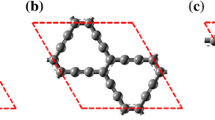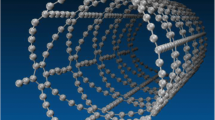Abstract
The electronic and optical properties of zigzag and armchair β-graphyne nanotubes (β-GNTs) and their BN analogues (labeled as β-BNyne NTs) with different tube diameters are systematically investigated by the first-principles calculations. The calculated results reveal that all zigzag and armchair β-graphyne nanotubes are direct band gap semiconductors. As for zigzag β-BNyne NTs, they are wide direct band gap semiconductors. Nevertheless, armchair β-BNyne NTs are indirect band gap semiconductor. The optical spectra of β-GNTs and BNyne NTs show remarkable anisotropic behavior. Interestingly, the static dielectric constant of β-GNTs is quite high in comparison with carbon NTs, indicating higher conductivity and carrier mobility. In addition, quite broad frequency absorption spectra, extended from the infrared to the ultraviolet (UV) region, are observed for all β-GNTs. However, the photoresponse of β-BNyne NTs is mainly located in the UV region. The β-GNTs exhibit high reflectivity in the infrared region of 0.0 to 1.5 eV for both parallel and perpendicular polarization, but all β-BNyne NTs possess very low reflectivity and are highly sensitive to the UV light. Particularly, all β-GNTs demonstrate no obvious size-dependent optical properties, however, for β-BNyne NTs, all the photoresponse intensity (static dielectric constant, reflectivity and absorption coefficient) decreases monotonically with increasing tube size.
















Similar content being viewed by others
References
Li Y, Xu L, Liu H, Li Y (2014) Graphdiyne and graphyne: from theoretical predictions to practical construction. Chem Soc Rev 43(8):2572–2586
Chen YH, Liu HB, Li YL (2016) Progress and prospect of two dimensional carbon graphdiyne (in Chinese). Chin Sci Bull 61(26):2901–2912
Wu WZ, Guo WL, Zeng XC (2013) Intrinsic electronic and transport properties of graphyne sheets and nanoribbons. Nanoscale 5(19):9264–9276
Hwang HJ, Koo J, Park M, Park N, Kwon Y, Lee H (2013) Multilayer graphynes for lithium ion battery anode. J Phys Chem C 117(14):6919–6923
Hwang HJ, Kwon Y, Lee H (2012) Thermodynamically stable calcium-decorated graphyne as a hydrogen storage medium. J Phys Chem C 116(38):20220–20224
Kou J, Zhou X, Lu H, Wu F, Fan J (2014) Graphyne as the membrane for water desalination. Nanoscale 6(3):1865–1870
Kang J, Li J, Wu F, Li SS, Xia JB (2011) Elastic, Electronic, and optical properties of two-dimensional graphyne sheet. J Phys Chem C 115(42):20466–20470
Kang B, Lee JY (2015) Electronic properties of α-graphyne nanotubes. Carbon 84:246–253
Kang B, Moon JH, Lee JY (2015) Size dependent electronic band structures of β- and γ-graphyne nanotubes. RSC Adv. 5(98):80118–80121
Majidi R, Karami AR (2015) Electronic properties of B- and N-doped graphyne nanotubes. Comput Mater Sci 97:227–230
Zhou H, Lu S, Li F, Qu Y (2016) Carbon nanoribbons and nanotubes based on δ-graphyne: a first-principles study. Physica E 78:19–24
Coluci VR, Braga SF, Legoas SB, Galvão DS, Baughman RH (2003) Families of carbon nanotubes: graphyne-based nanotubes. Rhys Rev B 68:035430
Wang XM, Lu SS (2013) Thermoelectric transport in graphyne nanotubes. J Phys Chem C 117(38):19740–19745
Bhattacharya B, Singh NB, Mondal R, Sarkar U (2015) Electronic and optical properties of pristine and boron-nitrogen doped graphyne nanotubes. Phys Chem Chem Phys 17(29):19325–19341
Coluci VR, Braga SF, Legoas SB, Galvão DS, Baughman RH (2004) New families of carbon nanotubes based on graphyne motifs. Nanotechnology 15(4):S142–S149
Coluci VR, Galvão DS, Baughman RH (2004) Theoretical investigation of electromechanical effects for graphyne carbon nanotubes. J Chem Phys 121(7):3228–3237
Li G, Li Y, Qian X, Liu H, Lin H, Chen N, Li Y (2011) Construction of tubular molecule aggregations of graphdiyne for highly efficient field emission. J Phys Chem C 115(6):2611–2615
Blase X, Rubio A, Louie SG, Cohen ML (1994) Stability and band gap constancy of boron nitride nanotubes. Europhys Lett 28(5):335–340
Chopra NG, Luyken RJ, Cherrey K, Crespi VH, Cohen ML, Louie SG, Zettl A (1995) Boron nitride nanotubes. Science 269(5226):966
Jia J, Wu H, Jiao H (2006) The structure and electronic property of BN nanotube. Phys B 381(1–2):90–95
Ahmad P, Khandaker MU, Khan ZR, Amin YM (2015) Synthesis of boron nitride nanotubes via chemical vapour deposition: a comprehensive review. RSC Adv 5:35116–35137
Jiang X, Weng Q, Wang X, Li X, Zhang J, Golberg D, Bando Y (2015) Recent progress on fabrications and applications of boron nitride nanomaterials: a review. J Mater Sci Technol 31(6):589–598
Zhang Y, Yun J, Wang K, Chen X, Yang Z, Zhang Z, Yan J, Zhao W (2017) First-principle study of graphyne-like BN sheet: electronic structure and optical properties. Comp Mater Sci 126:12–19
Özçelik VO, Ciraci S (2013) Size dependence in the stabilities and electronic properties of α-graphyne and its boron nitride analogue. J Phys Chem C 117:2175–2182
Yun J, Zhang Y, Wang K, Zhang Z (2016) Electronic structure and optical properties of graphyne-like BN nanotubes. Comp Mater Sci 123:79–84
Segall MD, Lindan PJD, Probert MJ, Pickard CJ, Hasnip PJ, Clark SJ, Payne MC (2002) First-principles simulation: ideas, illustrations and the CASTEPcode. J Phys: Condens Matter 14(11):2717–2744
Grimme S (2006) Semiempirical GGA-type density functional constructed with a long-range dispersion correction. J Comput Chem 27(15):1787–1799
Vanderbilt D (1990) Soft self-consistent pseudopotentials in a generalized eigenvalue formalism. Phys Rev B 41(11):7892–7895
Perdew JP, Burke K, Ernzerhof M (1996) Generalized gradient approximation made simple. Phys Rev Lett 77(18):3865–3868
Monkhorst HJ, Pack JD (1976) Special points for Brillouin-zone integrations. Phys. Rev. B 13(12):5188–5192
Clark SJ, Segall MD, Pickard CJ, Hasnip PJ, Probert MIJ, Refson K, Payne MC (2005) First principles methods using CASTEP: zeitschrift für Kristallographie–Crystalline Materials, Z. Kristallogr 220:567–570
Perkgoz NK, Sevik C (2014) Vibrational and thermodynamic properties of α-, β-, γ-, and 6, 6, 12-graphyne structures. Nanotechnology 25(18):185701
Lee SM, Lee YH, Huang YG, Elsner J, Porezag D, Frauenheim T (1999) Stability and electronic structure of GaN nanotubes from density-functional calculations. Phys Rev B 60(11):7788–7791
Sánchez-Portal D, Artacho E, Soler JM (1999) Ab initio structural, elastic, and vibrational properties of carbon nanotubes. Phys Rev B 59(19):12678–12688
Zhao M, Xia Y, Zhang D, Mei L (2003) Stability and electronic structure of AlN nanotubes. Phys Rev B 68:235415
Hernández E, Goze C, Bernier P, Rubio A (1998) Elastic properties of C and BxCyNz composite nanotubes. Phys Rev Lett 80(20):4502–4505
Robertson DH, Brenner DW, Mintmire JW (1992) Energetics of nanoscale graphitic tubules. Phy Rev B 45(21):12592–12595
Hua X, Agin T, Che J, Goddard WA III (2000) QM(DFT) and MD studies on formation mechanism of C-60 fullerenes. Nanotechnology 11(2):85–88
Ouyang M, Huang JL, Cheung CL, Lieber CM (2001) Energy gaps in “metallic” single-walled carbon nanotubes. Science 292(5517):702–705
Tibbetts GG (1983) Why are carbon filaments tubular? J Cryst Growth 66(3):632–638
Peng LM, Zhang ZL, Xue ZQ, Wu QD, Gu ZN, Pettifor DG (2000) Stability of carbon nanotubes: how small can they be? Phys Rev Lett 85(15):3249–3252
Zhang Z, Guo W, Dai Y (2009) Stability and electronic properties of small boron nitride nanotubes. J Appl Phys 105:084312
Liu L, Zhang L, Gao H, Zhao J (2011) Structure, energetics, and heteroatom doping of armchair carbon nanotori. Carbon 49:4518–4523
Kleiner A, Eggert S (2002) Curvature, hybridization, and STM images of carbon nanotubes. Phys Rev B 64(11):113402–113405
Ebbesen TW (1996) Carbon nanotubes. Phys Today 49(6):26–32
Blase X, Benedict LX, Shirley EL, Louie SG (1994) Hybridization effects and metallicity in small radius carbon nanotubes. Phys Rev Lett 72(12):1878–1881
Yi JY, Bernholc J (1993) Atomic structure and doping of microtubules. Phys Rev B 47(3):1708–1711
Ding JW, Yan XH, Cao JX (2002) Analytical relation of band gaps to both chirality and diameter of single-wall carbon nanotubes. Phys Rev B 66(7):073401
Heyd J, Scuseria GE, Ernzerhof M (2003) Hybrid functionals based on a screened coulomb potential. J Chem Phys 118:8207
Jana D, Chen LC, Chen CW, Chattopadhyay S, Chen KH (2007) A first principles study of the optical properties of B x C y single wall nanotubes. Carbon 45(7):1482–1491
Jain SK, Srivastava P (2013) Optical properties of hexagonal boron nanotubes by first-principles calculations. J Appl Phys 114(7):073514
Acknowledgements
This work is supported by the National Natural Science Foundation of China (Program No. 61306009) and the Science and Technology Star Project of Shaanxi Province (2013KJXX-24).
Author information
Authors and Affiliations
Corresponding author
Ethics declarations
Conflict of interest
The authors declare no competing financial interest.
Electronic supplementary material
Below is the link to the electronic supplementary material.
Rights and permissions
About this article
Cite this article
Yun, J., Zhang, Y., Yan, J. et al. Electronic and optical properties of β-graphyne nanotubes and their BN analogues. J Mater Sci 52, 13133–13148 (2017). https://doi.org/10.1007/s10853-017-1406-x
Received:
Accepted:
Published:
Issue Date:
DOI: https://doi.org/10.1007/s10853-017-1406-x




